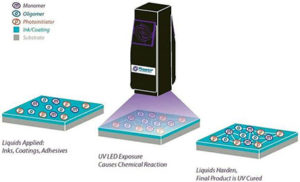LED curing solutions are utilized in the coatings industry because they offer highly reliable UV curing due to being a solid-state device. They provide deep through-cure and allow low surface temperatures that enable less expensive raw inputs.
UV curing technology with light-emitting diodes (LEDs) is considerably more eco-friendly and resource-saving compared to the traditional technologies. The disposal of heavy metal lamps made of gallium and mercury is no longer required. Working conditions for the line operators are improved as there is no ozone formation and an exhaust system is thus not necessary, which could lead to higher noise levels. The lower energy consumption of LED light sources contributes to the protection of resources.
Traditional UV lamps produce UV energy by generating an electric arc inside an ionized gas (typically mercury) chamber to excite atoms, which then decay, emitting photons. The photons emitted cover a broad range of the electromagnetic spectrum including some infrared and even visible light. Only about 20% is typically useful for UV curing.
“It’s now possible to use LED lamps in every step of the curing process, eliminating the need for conventional UV lamps altogether.”
Lars Sandqvist, Sr. Technical Application Manager, Sherwin-Williams
A UV LED generates UV energy in an entirely different way. As an electric current (electrons) moves through a semiconductor device called a diode, it emits energy in the form of photons. The specific materials in the diode determine the photon wavelengths and, in the case of UV LEDs, the output is typically in a very narrow band +/-10 nm. Figure 2 compares the output of a 395 nm LED light source with a typical traditional UV lamp. It is important to note the difference in intensity and wavelength of the output; both are key to understanding a UV curing process.
For efficient and effective UV curing of a coating, the formulator seeks to overlap the UV light source output with the spectral absorption of the photoinitiator (PI). The amount of PI in a typical UV formulation is usually very small, less than 5%. PIs typically absorb across a range of wavelengths, not a narrow band. Many existing UV formulations developed for curing with a typical UV lamp use a broad spectrum PI. While there is often some absorption within the LED output range, it is clear that much of the PI absorption range is wasted. A more efficient cure is possible with a formulation designed specifically for LED curing using a PI with more concentrated absorption in the UV-A range.
Last year, Sherwin-Williams announced a new LED innovation aimed at manufacturers within the wood finishing industry – Full Curing LED. This breakthrough technology makes it possible to implement LED throughout the entire curing line, allowing for even more energy savings and quality improvements than before.
“We´ve been working toward a solution like this since we first introduced LED curing in 2012. However, there was always a problem with unwanted yellowing effects due to difficulties with the topcoat. For a while, it seemed that a combination of LED and UV lamps was the only way to go, but we pushed forward and the R&D division finally came up with the right formula to make it work. It’s now possible to use LED lamps in every step of the curing process, eliminating the need for conventional UV lamps altogether. This will allow for a much more effective production”, says Lars Sandqvist, Sr. Technical Application Manager at Sherwin-Williams.
Tags: UV LED curing for Coating Applications | Coatings World Magazine | Sherwin-WilliamsCategories: Coatings | Inks
